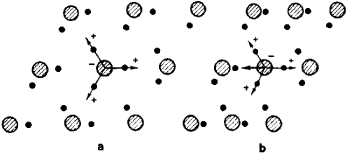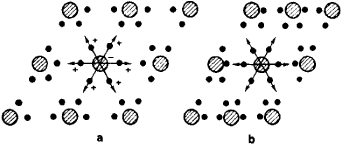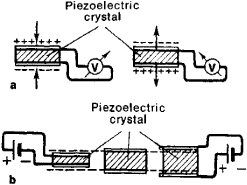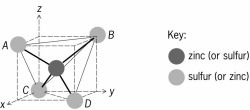Piezoelectricity
Source: 本站 Published: 2019/04/17
Electricity, or electric polarity, resulting from the application of mechanical pressure on a dielectric crystal. The application of a mechanical stress produces in certain dielectric (electrically nonconducting) crystals an electric polarization (electric dipole moment per cubic meter) which is proportional to this stress. If the crystal is isolated, this polarization manifests itself as a voltage across the crystal, and if the crystal is short-circuited, a flow of charge can be observed during loading. Conversely, application of a voltage between certain faces of the crystal produces a mechanical distortion of the material. This reciprocal relationship is referred to as the piezoelectric effect. The phenomenon of generation of a voltage under mechanical stress is referred to as the direct piezoelectric effect, and the mechanical strain produced in the crystal under electric stress is called the converse piezoelectric effect. See Polarization of dielectrics
The necessary condition for the piezoelectric effect is the absence of a center of symmetry in the crystal structure. Of the 32 crystal classes, 21 lack a center of symmetry, and with the exception of one class, all of these are piezoelectric. Hydrostatic pressure produces a piezoelectric polarization in the crystals of those 10 classes that show pyroelectricity in addition to piezoelectricity. See Crystallography;, Pyroelectricity
Quantitative theories based on the detailed crystal structure are very involved. Qualitatively, however, the piezoelectric effect is readily understood for simple crystal structures. The illustration shows this for a particular cubic crystal, zincblende (ZnS). Every Zn ion is positively charged and is located in the center of a regular tetrahedron ABCD, the corners of which are the centers of sulfur ions, which are negatively charged. When this system is subjected to a shear stress in the xy plane, the edge AB, for example, is elongated, and the edge CD of the tetrahedron becomes shorter. Consequently, these edges are no longer equivalent, and the Zn ion will be displaced along the z axis, thus giving rise to an electric dipole moment. The dipole moments arising from different octahedrons sum up because they all have the same orientation with respect to the axes x, y, and z.
The sharp resonance curve of a piezoelectric resonator makes it useful in the stabilization of the frequency of radio oscillators. Quartz crystals are used almost exclusively in this application. In vacuum-tube oscillators, the crystal generally is part of the feedback circuit. Selective band-pass filters with low losses can be built by using piezoelectric resonators as circuit elements. A synthetic piezoelectric crystal which is often substituted for quartz in this application is ethylene diamine tartrate.
Piezoelectric materials are used extensively in transducers for converting a mechanical strain into an electrical signal. Such devices include microphones, phonograph pickups, vibration-sensing elements, and the like. The converse effect, in which a mechanical output is derived from an electrical signal input, is also widely used in such devices as sonic and ultrasonic transducers, headphones, loudspeakers, and cutting heads for disk recording.
The principal piezoelectric materials used commercially are crystalline quartz and rochelle salt, although the latter is being superseded by other materials, such as barium titanate. Quartz has the important qualities of being a completely oxidized compound (silicon dioxide), and is almost insoluble in water. Therefore, it is chemically stable against changes occurring with time. It also has low internal losses when used as a vibrator. Rochelle salt has a large piezoelectric effect, and is thus useful in acoustical and vibrational devices where sensitivity is necessary, but it decomposes at high temperatures (131°F or 55°C) and requires protection against moisture. Barium titanate provides lower sensitivity, but greater immunity to temperature and humidity effects. Other crystals that have been used for piezoelectric devices include tourmaline, ammonium dihydrogen phosphate (ADP), and ethylenediamine tartrate (EDT).
the phenomenon that describes both the polarization that arises in a dielectric as a result of an applied mechanical stress and the mechanical strain that occurs as a result of an applied electric field. The former is known as the direct piezoelectric effect, and the latter as the converse piezoelectric effect. Direct and converse effects can both be observed in the same piezoelectric crystals.
The first detailed investigation of piezoelectric effects was conducted in 1880 by the brothers Jacques and Pierre Curie on quartz crystals. Later on, piezoelectric properties were found in more than 1,500 substances, including the widely used Rochelle salt and barium titanate.
The piezoelectric properties of a crystal are associated with its structure. Pyroelectrics, or spontaneously polarized dielectrics, also exhibit these properties. Mechanical strain in a pyroelectric will change the magnitude of its spontaneous polarization; thus, a direct piezoelectric effect is observed. Piezoelectric effects are also observed in certain nonpyroelectric substances, such as quartz. It is valid to state, as a general principle, that crystals having a center of symmetry cannot exhibit piezoelectric effects. This is because the crystal’s center of symmetry remains intact during strain, and as long as a center of symmetry exists, there can be no polarization (Figures 1 and 2). Polarization may be ruled out along certain directions or with certain strains if the crystal is symmetric along a given axis or in a given plane.
In a given crystal, the quantitative piezoelectric properties are given by the piezoelectric constants and piezoelectric strain coefficients. These are coefficients of proportionality that relate electrical quantities, such as the intensity of the electric field E or the polarization P, to mechanical quantities, such as mechanical stress σ or relative strain u. In the equation P = d σ, the coefficient d is one of the piezoelectric constants. Since any arbitrary mechanical stress can be represented as a total of six independent stresses and since the polarization vector P has three independent components, there can be 18 possible piezoelectric constants. The symmetry of the crystal, however, limits the number of constants that are independent and differ from zero. The magnitude of d depends on the experimental conditions.
Molecular theory
Applications
Piezoelectric materials
Piezoelectricity




Copyright © Ningbo ChenTe Electronics Technologies co.,Ltd
Add :No 6. First Rd, Western Industrial Park,Lubu town, Yuyao Zhejiang 315420 China

